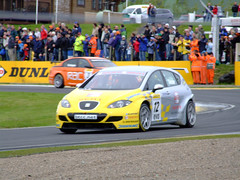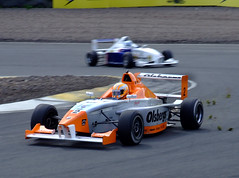Water, Water, Everywhere
The 1976 race was a championship decider. This time round, it was not mathematically possible that the title could be settled in the shadow of Mount Fuji, but the result leaves Messrs Alonso and Raikkonen with only little more than a mathematical chance of coming away with the driver's crown. Neither man can really win the world championship, with Hamilton requiring only a pair of 4th places, but Lewis could still lose it, especially if it were to rain in Shanghai and this time it was his Mclaren that went off the road.
Certainly, if he does win the world title, the Japanese Grand Prix will be a pretty fine illustration of why he deserved it. In atrocious conditions, he put in a drive of control and accomplishment while his double world champion team mate went into the wall trying to keep up. As for Ferrari... the tyre fiasco was frankly the perfect illustration of where they have gone wrong this year. The car looked to have the pace, and Raikkonen and Massa both put in solid, aggresive drives in difficult circumstances...but what on earth were they doing starting on Inters? Leaving aside the fact that, had they read their email, they would have known they could not start on those tyres, the rubber was plainly not up to the job anyway. Judging by their performances under the safety car (a spin apiece), they would have ended up going straight off the road had they still been on inters when they began racing. A fantastic opportunity was thrown away by poor team management. How they must be hoping Ross Brawn will elect to return...
Behind all this, or, as often as not, in front, the race provided a rare opportunity for those whose talent exceeds the performance of their car to show what they could do (or, just possibly, to show how good the RB3 is in the wet...). The super-smooth Jenson Button used his famouly delicate inputs to claim a fine 6th spot on the grid in a Honda that frankly has no business being there. Had he not lost his nose early in the race, who knows what he might have achieved.
If Button was disappointed, Mark Webber must have been absolutely livid. The perennially luckless Aussie had his Red Bull in second place and appeared to have the pace to give Hamilton something to think about when rookie Sebastien Vettel ran into him and eliminated them both from proceedings....under a safety car. Vettel was distraught and could be seen crying, head in his hands, after climbing out of his wrecked Toro Rosso. Webber, who was sick into his helmet in the early laps and really not well enough to race, must have felt even more violently ill by the end of the day.
Let's not forget, though, that until that moment, Vettel's own performance was remarkable in its own right. His run to third place (he had led briefly) certainly didn't look like the work of a 20 year old with just six starts to his name in a tail end car. As someone who, up to now, had wondered quite what either Red Bull or BMW saw in Vettel, I feel I got an answer on Sunday. In years to come, we may remember his Fuji performance as his 'Senna in the wet in a Toleman' moment, rather than for the tragic error which brought it to an end.
The odds on rain in Valencia, where the GP2 series was being decided, must have been rather longer. Nonetheless, that's what they got. I've said before that it would be a travesty if the uninspiring Lucas Di Grassi beat Timo Glock to the title, and I must confess that when I realised the conditions were to be a wet/dry lottery of a race, I wondered if this might be precisely what would happen.
As it is, it was Di Grassi who lost out. Stuck on the wrong tyres at the beginning (as was Glock) he was caught out when he emerged on slick tyres and skated off into retirement in the turn 2 gravel trap. One might call it bad fortune, but in a season where Glock had been plagued with poor luck, it seemed only reasonable.
Timo sealed the title with a win in the Sunday sprint race - his fifth of the season. Had it not been for myriad misfortunes, he might have won twice as many. The big surprise ofthe weekend, though, was that Vitaly Petrov won the feature race - and from the front, outpacing his more experienced team mate in the process. I have to confess I would never have fingered him as a race winner at the beginning of the season. After all, there have been an awful lot of wealthy, but fundamentally pretty useless Russian kids in single seater racing over the last few years (see Victor Maslov, Sergei Zlobin and anyone who ever had anything to do with the Russian A1GP team) and I assumed Petrov was simply the latest of these. You don't win a race on a damp track on slick tyres without being pretty handy though, and Petrov has laid down a marker that he may be a man to watch if he comes back for another season next year. With Mikhail Aleshin showing some form in the Renault World Series, we could at last be seeing something of a breakthrough for the backwater that is Russian motorsport.
If nothing else, the weekend gone has shown that you don't need overtaking working groups, reverse grids, ballast systems, push-to-pass buttons or any of the rest of that nonsense to make single seater racing exciting to watch. You just need a wet track. Now, Bernie.... Howabout scrapping this night race lark in Singapore and demanding that they install some trackside sprinklers instead?
Labels: f1, formula 1, fuji. japanese grand prix, gp2. lewis hamilton, jenson button, mark webber, motorsport, rain, red bull, sebastien vettel, timo glock, valencia







